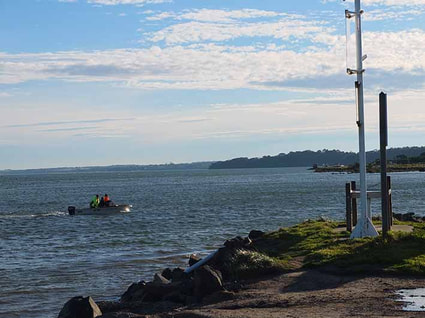 Mahers Landing is no place for millionaires’ yachts, but it has plenty of riches for those who are willing to see.
Mahers Landing is no place for millionaires’ yachts, but it has plenty of riches for those who are willing to see. WHEN you first arrive at the Mahers Landing carpark, you might be underwhelmed. There’s a basic boat ramp, a fish cleaning table, a navigation beacon and a toilet block. At high tide there’s an expanse of water with Venus Bay on the distant shore. At low tide, you can see expansive mudflats dissected by sinuous channels. This is Andersons Inlet, the estuary of the Tarwin River.
Directly in front of the carpark, Zostera seagrass is establishing, along with a few white mangrove seedlings. As the days become longer, the sunlight will allow these plants to photosynthesis and grow long and lush, providing habitat and food for all manner of marine creatures. Their roots will bind and stabilise the mud, protecting the low shoreline from erosion. The seagrasses are not algaes or seaweeds but flowering plants, or angiosperms, which have cleverly adapted to a marine lifestyle, as have the mangroves.
Estuaries are a fascinating place to observe, the meeting place of river and ocean, land and water. The conditions are constantly changing – tides, floods, light and salinity provide a challenging but rich environment allowing all sorts of odd, interesting and important creatures to thrive. During a period of flood, brown trout from the Tarwin River may appear, and in the high tide salt water you may see a gummy shark nosing about in search of a tasty sand crab.
I’ve spent more than 40 years boating in this area. The boat ramp is a perfect launching site for kayaks and the humble “tinnie”. Larger, more elaborate vessels may find the mud and shallow waters difficult to negotiate. This is not a place for captains’ hats, deck shoes and floating gin palaces. It is for those of us who can handle wet, muddy feet and minimalist vessels. There are no launching fees – ramp users understand this means minimal facilities. It tends to deter the speed freaks with fast boats and hoons on jet skis. The shallow waters will soon sort out those who are foolish and unobservant.
There are few better ways to spend a day than pottering about in a small boat, casting a line and watching the birds ply their craft. There is always some new natural wonder to ponder. On my last trip, a white-bellied sea eagle was hunting for fish. It swooped down less than 20 metres behind the boat, snatching a largish fish from the surface, close enough to enable a view of its wicked talons. Unlike many raptors, the sea eagle has a short stubby tail. This close-up display enabled me to work out why this is so. Long tail feathers would drag along the surface of the water upsetting the bird’s ruthlessly efficient hunt. They seemingly have the ability to control individual wing feathers, adjusting for slight wind changes – simply wonderful to view – true masters of their world.
Under the water there were large numbers of ascidians, or sea-squirts, gently rolling along the bottom of the channel. A few were caught on my fishing line, which enabled a closer look. They were like a small kiwifruit – brown and furry capsules, the leathery case protecting a gelatinous interior. A pair of siphons allow them to filter water and trap tiny morsels of food. They look to be very primitive organisms, yet have a rather complex nervous system, more highly organised than many invertebrates. They usually attach to a rock or mangrove root, leading a sedentary lifestyle. So why were these ones seemingly migrating towards Inverloch? The weather had been benign – perhaps it was a Sunday jaunt.
The trip before – several weeks earlier – there were hordes of tiny snapper in the channel, pinching our baits within seconds. Only about 10cms long, these voracious little chaps would have been spawned in the inlet the previous spring. The rich food sources of the estuary aids their growth and, as the tide flooded and darkness encroached, they would swim up into the shallows to feast and maraud.
Over the next few years some of the growing fish will leave this estuary, repopulating the Bunurong coastal waters. Others may make a longer trip around Wilsons Prom and eastward along the Gippsland coast, perhaps even into southern NSW. A prime example of the far-reaching beneficial effects of a healthy estuary. Commercial netting was banned in Andersons Inlet some years ago, allowing many fish species the opportunity to breed.
Readers may be aware that Mahers Landing has been mooted as a site for a large marina and residential development. Information sessions have spruiked the benefits of “environmental improvements”. While the developer has not divulged how many residences he proposes to build, there are rumours of a gated community and helicopter-loads of rich tourists and international visitors.
Part 2: Why a rich man’s playground may not be appropriate for this local jewel, and the tiny critically endangered fish that may have the power to scuttle the development.